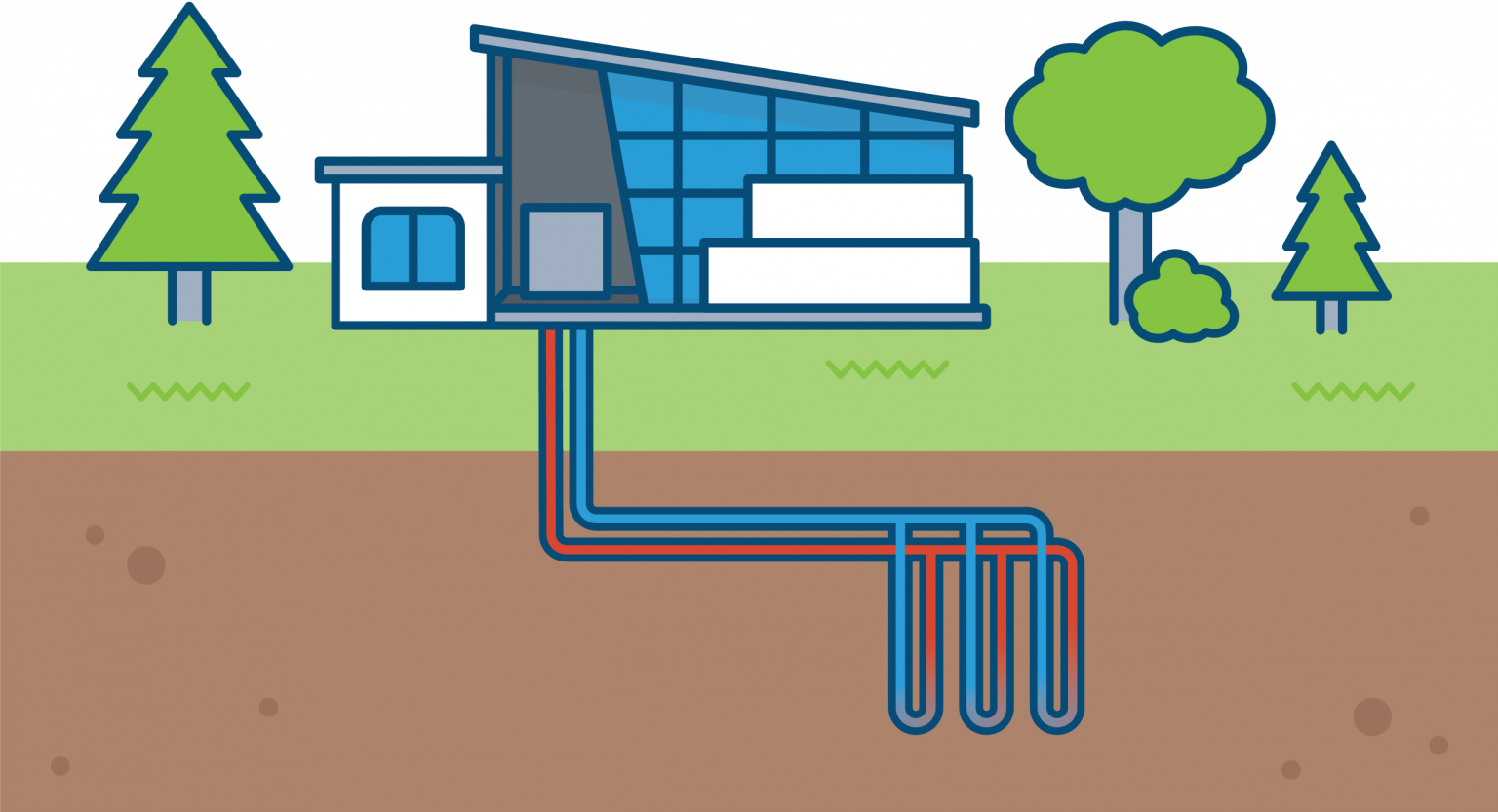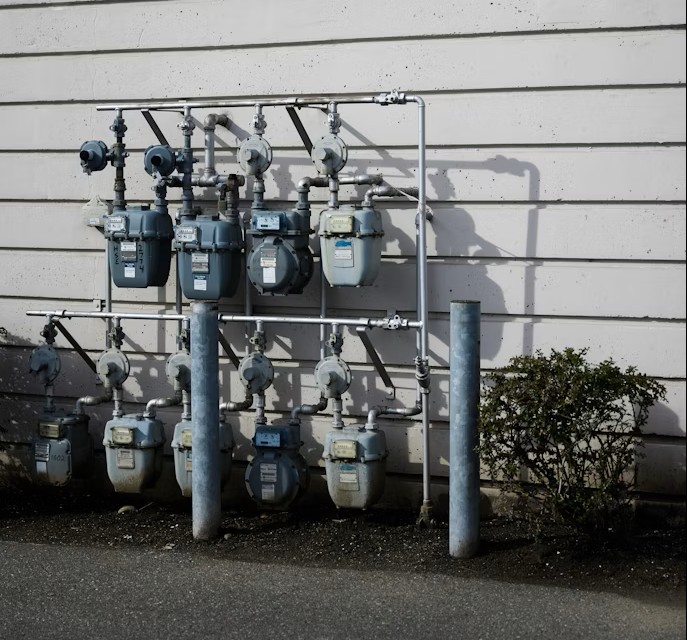

By Chase Macpherson | Wed, September 3, 25
When you hear “heat pump,” do you picture an air source heat pump? Is it residential? You’re not alone - that’s the most common application. But in the past few years, the region has done more with ground source and thermal energy networks for residential and commercial applications. This post provides an overview of these technologies, examples of projects from across the region, and information on how you can learn more at NEEP’s upcoming workshop in Princeton, NJ in October.
What is a Ground Source Heat Pump?
A ground source heat pump (GSHP) uses the relatively consistent temperature underground to move heat from the ground into indoor spaces in the winter, and from indoor spaces into the ground during the summer. Because the average temperature just a few feet underground is around 55 degrees Fahrenheit in the Northeast, ground source systems can effectively heat and cool buildings year-round no matter how cold it is outside.
Geothermal systems (often referred to as ground source heat pumps) feature boreholes that are drilled 100 to 500+ feet deep and lined with pipes that circulate an antifreeze-water solution. During the water’s journey through the underground pipes, the liquid either warms up or cools down depending on the season. It then moves through a heat pump which, during winter, extracts heat from the solution and distributes it into the building to provide space heating. As with any type of heat pump, moving heat is far more efficient than generating it. GSHPs are suitable for both residential and commercial applications. Because the temperature underground is stable and consistent year-round, geothermal systems are highly efficient.
What is a Thermal Energy Network?
A Thermal Energy Network, or TEN, is a form of district heating that connects multiple buildings, heat sources, and heat sinks together into an integrated system. The system collects and distributes heat between different buildings and heat sources/sinks to provide heating and cooling for indoor spaces. TENs often include geothermal bores as a heat source and can build on the efficiency of ground source heat pumps. Geothermal energy networks can reach efficiency of over 600 percent.
In 2023, NEEP joined a project led by the Connecticut Department of Energy and Environmental Protection (CT DEEP) to assess the feasibility of networked geothermal for a public housing development in Wallingford, CT. NEEP conducted a workforce needs assessment, created a workforce development plan for the geothermal heating and cooling industry in Connecticut and assisted with community engagement. The project demonstrated the significant opportunities and challenges associated with these deploying thermal energy networks, including identifying a site with sufficient load diversity, ensuring there is a qualified workforce to install the system, and educating and engaging residents in the process.
Two Kinds of Heat that TENs can Leverage
Thermal Energy Networks can utilize different thermal resources. The ground is a very common source of, or sink for, heat for these systems. For the project with CT DEEP, NEEP and its partners evaluated the feasibility of using thermal energy and ground source heat pumps to provide heating and cooling to 132 units of public housing across 38 buildings.
Waste heat from buildings, wastewater systems, and other sources provide heating resources for TENs. TENs that utilize waste heat sources still require buried piping to circulate fluid between heat-exporting and heat-importing buildings. One hypothetical example of a system that utilizes waste heat is carrying excess heat produced by a data center to a residential building nearby that needs heating. Data centers are commonly cited as a potential heat source for TENs because they have very high cooling needs. The natural heat produced in wastewater pipes can also provide usable heat for TENs. There are water-to-water heat pump systems that use the heat from domestic wastewater to preheat potable water before it is brought up to full temperature. This water can then be used in a domestic water heater or fed into a hydronic heating system. The use of waste heat can also reduce the number of geothermal boreholes needed, which can reduce upfront costs for the project.
Neighborhood-Scale Potential
TENs have the potential to decarbonize entire neighborhoods, making them a highly effective tool for community-level decarbonization. The Building Decarbonization Coalition (BDC) created a map of TENs across the country, which shows the relatively high density of projects in the NEEP region. These systems can include homes, offices, stores, government buildings, emergency services, hospitals, and more. In fact, the more diverse the heating and cooling needs are across connected buildings (think data centers, municipal buildings, multifamily properties, food storage facilities, and other industrial buildings) the more efficient the system can be.
Conversely, if the buildings have limited load diversity, the system will need to handle a relatively high ‘peak demand’ (the time of day when the system provides a large volume of heat and cooling to connected users). It’s ideal for the buildings to be a mix of commercial and residential, due to the variation in need for cooling or heating at different times of the day. A group of houses with similar heating and cooling needs would not benefit as much from a networked system as a neighborhood with housing, a grocery store, a laundromat, etc. Vermont Community Thermal Networks provides many fact sheets and case studies on neighborhood-scale TENs.
Ownership Models
TENs can accommodate a variety of ownership models. It might seem strange that a gas utility would do anything other than serve its customers natural gas, but there is movement to enable and even require gas utilities in the U.S. to pilot geothermal TENs projects. At their core, TENs and gas distribution systems are not so different. Both use underground pipes to facilitate heating or cooling to groups of buildings that are close together. Underground boreholes that are used for gas distribution can also be used for water distribution in a TEN, and TENs offer a solution that is zero emissions.
In several states, legislatures have allowed or directed gas utilities to pilot Utility Thermal Network Systems (UTENs). Two examples include the first ever legislation in the country to allow gas utilities to pilot geothermal networks in Massachusetts and the 2022 Utility Thermal Energy Networks and Jobs Act in New York, which required the Public Utilities Commission to direct utilities to commence thermal energy network pilots in each major utility territory. Maryland’s WARMTH Act, passed in 2024, requires that gas utilities with more than 75,000 customers propose one to two TENs pilots with provisions and supports that allow smaller utilities to participate. The Act also supports organized labor, which can help ensure that economic benefits are evenly distributed through the creation of well-paying, stable jobs.
June 2024 marked the launch of the first thermal energy network pilot by a gas utility in the country in Framingham, MA. This system is owned and operated by Eversource Energy and is comprised of a mile-long horizontal loop connecting thirty-six buildings to geothermal heating and cooling, including a public housing property, a fire department, private residences, a gas station, and more.
Municipalities can also own and operate neighborhood-scale TENs, especially if they already operate municipal water and sewage divisions. Municipal water systems are very similar to TENs in terms of public infrastructure needs, and the presence of wastewater in sewage can be leveraged for its heat. See this fact sheet from Vermont Community Thermal Networks for more information on how municipalities can be a good fit as TENs owners. Universities, developers, electric utilities, and others can own TENs as well. For more information, see this primer on ownership models.
Stay Looped-In
If you are interested in learning more about early results from neighborhood-scale TENS projects in the Northeast and Mid-Atlantic, join us for NEEP’s HEW2025, on October 20-22 in Princeton, NJ. HEW 2025 will feature a networked geothermal case study, highlight the factors that made the project successful, and share lessons learned and best practices related to Thermal Energy Networks. Register here today!
Diagram via Efficiency Manitoba



